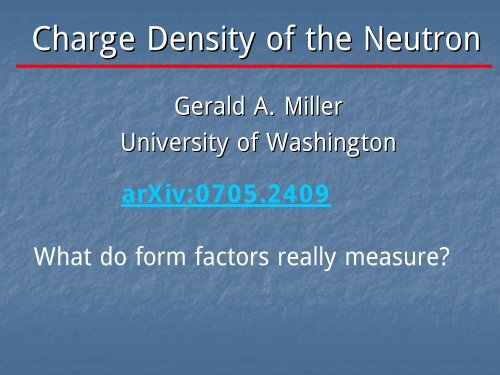Charge Density of the Neutron
Charge Density of the Neutron
Charge Density of the Neutron
You also want an ePaper? Increase the reach of your titles
YUMPU automatically turns print PDFs into web optimized ePapers that Google loves.
<strong>Charge</strong> <strong>Density</strong> <strong>of</strong> <strong>the</strong> <strong>Neutron</strong><br />
Gerald A. Miller<br />
University <strong>of</strong> Washington<br />
arXiv:0705.2409<br />
What do form factors really measure?
What is charge density at <strong>the</strong><br />
center <strong>of</strong> <strong>the</strong> neutron?<br />
<strong>Neutron</strong> has no charge, but charge density<br />
need not vanish<br />
Is central density positive or negative?
TTM<br />
4π r 2 ρ n (r)<br />
One gluon exchange also gives<br />
positive central charge density
Enough models- models models- Today<br />
model independent independent<br />
information
Outline<br />
Electromagnetic form factors<br />
Light cone coordinates, kinematic<br />
subgroup<br />
GPDs + Bit <strong>of</strong> math<br />
Two dimensional Fourier transf. transf.<br />
<strong>of</strong> F gives ρ(b), (b), Soper ’77 77<br />
1 Data analysis, Interpretation
Definitions<br />
Old Interpretation- Breit frame<br />
G E is helicity flip matrix element <strong>of</strong> J 0<br />
2
Interpretation <strong>of</strong> Sachs - G (Q E 2 Interpretation <strong>of</strong> Sachs - GE(Q (Q ) is 2 ) is<br />
Fourier transform <strong>of</strong> charge density<br />
Correct non-relativisticaly<br />
φ invariant under Galilean transformation<br />
--<br />
φ is frame dependent,<br />
interpretation <strong>of</strong> Sachs wrong
Why relativity if Q2 ¿ M2 Why relativity if Q 2 ¿ M2 QCD- QCD photon hits ≈ massless<br />
quarks<br />
No matter how small Q 2 is, <strong>the</strong>re<br />
is a boost correction that is ∝ Q2 F ∼ Q 1 2<br />
RN<br />
2 (|ψ| (| 2 +C/(m qRN) 2 )
Light Light cone cone coordinates<br />
coordinates
Relativistic formalism-<br />
kinematic subgroup <strong>of</strong> Poincare<br />
Lorentz transformation –transverse transverse<br />
velocity v<br />
k - such that k 2 not changed<br />
Just like non-relativistic
Generalized Parton Distribution<br />
A + =0, t=(p-p’) 2 = -Q 2 =-
H q (x,0)=q(x) (PDF)<br />
transverse center <strong>of</strong> mass R
Burkardt<br />
Integrate on x, Left: sets x - =0 q + † (0,b) q+ (0,b)<br />
DENSITY; right 2 Dim. Fourier T. <strong>of</strong> F 1
<strong>Density</strong><br />
RESULT<br />
τ=Q 2 /4M 2<br />
(2π) 2<br />
Soper ‘77
hep-ex/0602017
Results<br />
Kelly<br />
BBBA<br />
Negative
Negative F 1<br />
means central<br />
density negative<br />
GeV<br />
G<br />
2<br />
GeV 2
<strong>Neutron</strong> Interpretation<br />
0.005<br />
1<br />
0.5<br />
0.1<br />
0.05<br />
0.01<br />
-<br />
+<br />
b<br />
0 1 2 3 4 5 6<br />
? π - at short distance ?
<strong>Neutron</strong> Form Factors in LFCBM<br />
Miller 2002<br />
These give negative F 1
<strong>Charge</strong> symmetry: u in proton is d in<br />
neutron, d in proton is u in neutron<br />
ρ u =ρ p -ρ n /2 ρ d =ρ p -2ρ n<br />
ρ p =4/3ρ u -2/3 ρ d
?Quark interpretation?<br />
b=0, high transverse momentum, low<br />
Bjorken x<br />
low x, sea<br />
u u<br />
-<br />
u is suppressed by Pauli principal,<br />
Signal & Thomas
Summary<br />
Model independent information on charge<br />
density<br />
• Central charge density <strong>of</strong><br />
neutron is negative<br />
• Pion cloud at large b

















